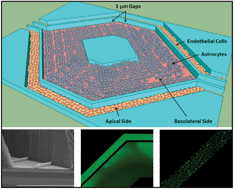SyM-BBB: a microfluidic blood brain barrier model
Abstract
Current techniques for mimicking the Blood–Brain Barrier (BBB) largely use incubation chambers (Transwell) separated with a filter and

* Corresponding authors
a
Biomedical Technology, CFD Research Corporation, Huntsville, AL 35805, USA
E-mail:
bxp@cfdrc.com
b Department of Pediatrics, Vanderbilt University Medical Center, Nashville, TN 37232, USA
c Kennedy Center for Research on Human Development, Vanderbilt University Medical Center, Nashville, TN 37232, USA
d Department of Pharmacology, Vanderbilt University Medical Center, Nashville, TN 37232, USA
Current techniques for mimicking the Blood–Brain Barrier (BBB) largely use incubation chambers (Transwell) separated with a filter and

 Please wait while we load your content...
Something went wrong. Try again?
Please wait while we load your content...
Something went wrong. Try again?
B. Prabhakarpandian, M. Shen, J. B. Nichols, I. R. Mills, M. Sidoryk-Wegrzynowicz, M. Aschner and K. Pant, Lab Chip, 2013, 13, 1093 DOI: 10.1039/C2LC41208J
To request permission to reproduce material from this article, please go to the Copyright Clearance Center request page.
If you are an author contributing to an RSC publication, you do not need to request permission provided correct acknowledgement is given.
If you are the author of this article, you do not need to request permission to reproduce figures and diagrams provided correct acknowledgement is given. If you want to reproduce the whole article in a third-party publication (excluding your thesis/dissertation for which permission is not required) please go to the Copyright Clearance Center request page.
Read more about how to correctly acknowledge RSC content.
 Fetching data from CrossRef.
Fetching data from CrossRef.
This may take some time to load.
Loading related content
